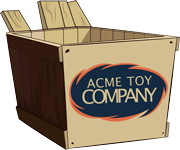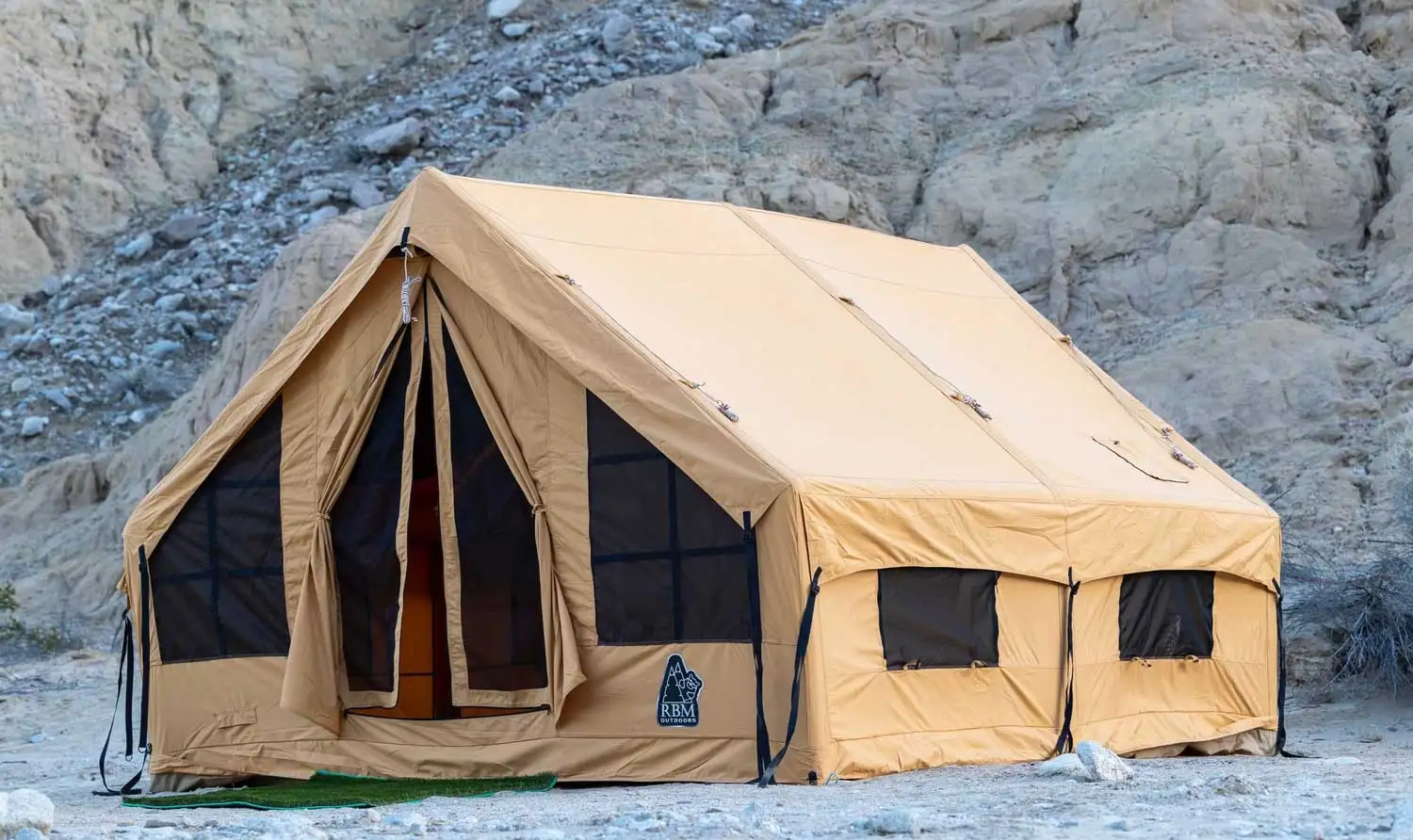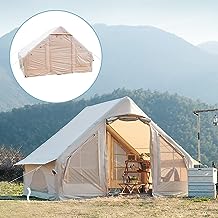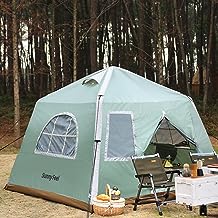A list of the pros of inflatable tents
Inflatable tents, oh how they have revolutionized the camping world! These ingenious creations have quickly gained popularity among outdoor enthusiasts, and it’s not hard to see why.
Let me enlighten you with a list of pros that will make you consider ditching your traditional tent in favor of these magnificent inflatable wonders. First and foremost, let’s talk about convenience.
Inflatable tents are an absolute breeze to set up. Gone are the days of wrestling with tangled tent poles and struggling to decipher confusing instructions.
With an inflatable tent, all you need is a pump, a few minutes of your time, and voila! Your cozy abode for the night is ready!
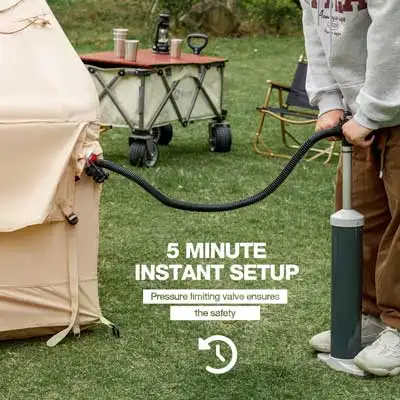
The simplicity of this process not only saves you time and effort but also reduces the risk of losing crucial parts or damaging your tent in the process. But wait, there’s more!
Inflatable tents are incredibly lightweight compared to their traditional counterparts. This makes them ideal for hikers or backpackers who value every ounce they carry on their adventures.
No longer do you need to compromise on comfort just to lighten your load. With an inflatable tent, you can enjoy ample space for sleeping and storage without feeling like you’re carrying around a small elephant on your back.
Additionally, let’s not forget about durability. Many inflatable tents are constructed using high-quality materials that can withstand even the harshest weather conditions Mother Nature throws at them.
Whether it be strong gusts of wind or torrential downpours, these sturdy structures stand tall like warriors defending their occupants from the elements. And unlike traditional tents that may suffer damage if one pole breaks or tears occur in critical areas, inflatable tents tend to distribute stress evenly across their structure – minimizing the risk of catastrophic failure.
Inflatable tents offer a level of convenience, portability, and durability that is unmatched by traditional tents. Their easy setup process ensures hassle-free camping experiences while their lightweight design caters to the needs of adventurers on the move.
Coupled with their resilience in challenging weather conditions, it’s hard to argue against the practicality and allure of these modern marvels. So, dear outdoor enthusiasts, it’s time to inflate your camping game and embrace the revolution that is inflatable tents!
A list of the cons of inflatable tents
Inflatable tents, while innovative and convenient in many ways, do come with their fair share of drawbacks. It is imperative to explore these cons before making the decision to invest in such a tent.
One prominent drawback is the potential for punctures. Unlike traditional tents made of sturdy materials like canvas or nylon, inflatable tents are susceptible to being punctured by sharp objects or rough surfaces.
Imagine the frustration of setting up camp in a beautiful location only to discover that your inflatable tent has been rendered useless due to a small hole. This vulnerability makes inflatable tents less durable and reliable compared to their traditional counterparts.
Moreover, it is worth noting that setting up an inflatable tent can be more time-consuming than anticipated. While manufacturers often boast about the quick setup process, it oftentimes requires multiple steps and can be quite complicated for first-time users.
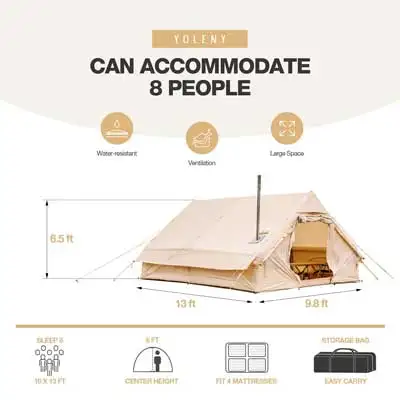
Instead of simply erecting poles and securing ropes like with traditional tents, inflatable tents require attaching an air pump, inflating each chamber individually, and ensuring that they are properly sealed off from one another. This tedious process can result in frustration and wasted time during camping trips when one would rather be exploring nature or relaxing around the campfire.
Another significant disadvantage of inflatable tents revolves around their susceptibility to extreme weather conditions. While most modern models are designed with weather resistance in mind, they still lack the structural stability provided by traditional tents designed specifically for harsh environments such as strong winds or heavy snowfall.
Acme Toy Company has found the flexible nature of the inflatable material may make these types of tents more prone to collapsing under extreme circumstances. Furthermore, if you enjoy camping in remote areas where electricity is not readily available, you might find yourself struggling with inflating an inflatable tent without access to a power source for your pump.
This limitation contradicts the idea of freedom associated with camping adventures as it restricts your choice of camping locations based on power availability. While there are undoubtedly some benefits associated with inflatable tents – such as easier transportation and increased versatility – it is essential not to overlook their drawbacks.
Potential punctures, time-consuming setup processes, vulnerability to extreme weather conditions, and reliance on electricity for inflation are all factors that must be taken into account when considering the purchase of an inflatable tent. It is crucial to evaluate your camping needs and preferences carefully before deciding if an inflatable tent is the right choice for you.
A comparison of the pros and cons of inflatable tents and traditional tents
When it comes to comparing inflatable tents with their traditional counterparts, the differences are as vast as the expanse of a starry night sky. Let us delve into the wondrous realm of these two tent options, examining their pros and cons with a discerning eye. Firstly, let us explore the majesty of traditional tents.
These structures have stood the test of time, embodying a sense of nostalgia and ruggedness. Traditional tents are often made from durable materials such as canvas or nylon, providing a robust defense against the elements.
Furthermore, their sturdy construction allows for greater stability even in adverse weather conditions. Picture yourself huddled inside, listening to raindrops dance on its fabric like an enchanting symphony.
Traditional tents offer an unparalleled sense of connection to nature and a respite from our bustling modern lives. However, like any majestic creation, traditional tents have their shortcomings too.
One cannot ignore their sheer size and weight when packed away for transport. Carrying these behemoths up mountains or through dense forests can quickly transform into an arduous odyssey.
Additionally, setting up traditional tents requires patience and skill – it’s not for the faint-hearted or those lacking in spatial intelligence! As you struggle with poles and pegs while desperately trying to decipher that cryptic instruction manual, doubt creeps in: Did I really sign up for this camping adventure, or did I mistakenly stumble into an elaborate puzzle game?
A buyer’s guide to help you choose the right type of tent for your needs
When it comes to choosing the perfect inflatable tent, there are several factors that need to be considered. The first and foremost is the size of the tent. Are you planning a solo camping adventure or will you be bringing along your entire clan?
It is essential to determine how many people the tent needs to accommodate comfortably. Keep in mind that while some tents claim to sleep four people, they may not provide ample space for everyone’s belongings or allow room for movement once inside.
Therefore, it is wise to choose a tent that offers a slightly larger capacity than needed, ensuring everyone has enough space to sleep and store their gear. Another crucial aspect is the ease of setup.
Inflatable tents are known for their convenience and time-saving features, but not all models are created equal in this regard. Look for tents with a simple and straightforward inflation system, preferably one that requires minimal effort and time.
The last thing you want is to struggle with complicated instructions or wrestling with an uncooperative air pump while your fellow campers stare at you in disbelief! Additionally, consider the durability of the materials used in construction.
Opt for tents made from high-quality materials such as heavy-duty PVC or reinforced polyester fabric to ensure longevity and resistance against wear and tear. Next on our list of considerations is weather resistance.
A reliable inflatable tent should be able to withstand various weather conditions without compromising its structural integrity or leaking during rainfall. Look for tents equipped with sturdy rainfly covers or additional waterproof coatings on the fabric itself.
Ventilation should also be taken into account since condensation can become a nuisance during warmer nights if there isn’t proper airflow within the tent. Furthermore, don’t overlook portability when selecting an inflatable tent.
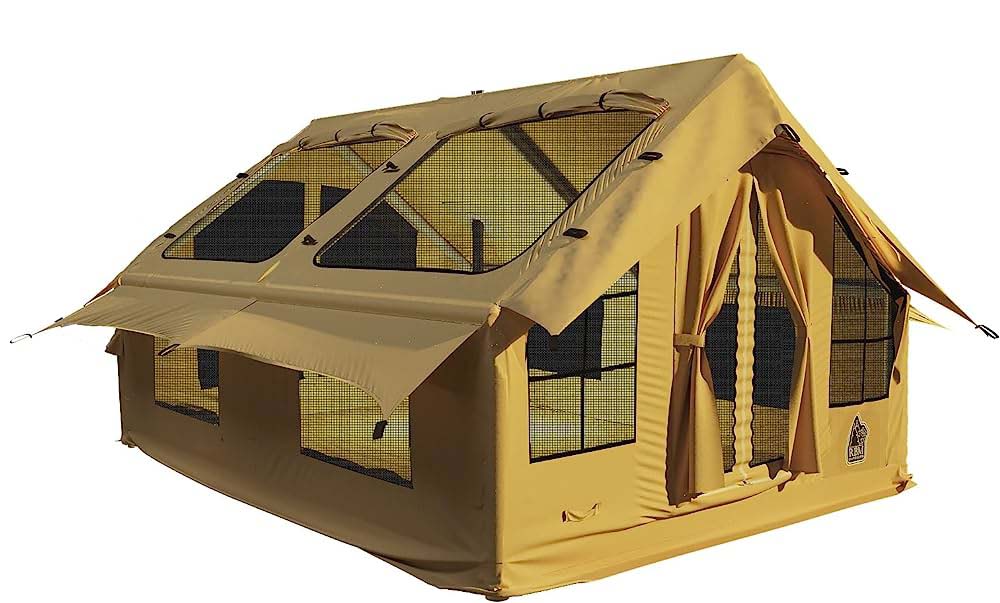
If you are planning frequent hiking trips where weight matters, choose a lightweight model that can easily fit into your backpack without burdening you on your journey through nature’s wonders. Take price into account but remember that quality often comes with a price tag.
It may be tempting to opt for a cheaper option, but compromising on the quality of your tent can lead to discomfort and potential issues in the long run. Consider your budget carefully and try to strike a balance between affordability and durability.
Choosing the right inflatable tent involves assessing various factors such as size, ease of setup, durability, weather resistance, portability, and price. By carefully considering these aspects based on your specific needs and preferences, you can ensure that you select a tent that will serve as a reliable shelter during your outdoor adventures for years to come.
Overall
After thoroughly analyzing the pros and cons of inflatable tents, it is clear that they offer a unique set of advantages and disadvantages. On the positive side, these tents are incredibly easy to set up and take down, making them ideal for campers who value convenience and efficiency.
The use of air instead of traditional poles also means that they are lighter in weight, making transportation a breeze. Additionally, the durability and resistance of inflatable tents to harsh weather conditions such as wind and rain is certainly impressive.
However, it would be remiss not to acknowledge the downsides of inflatable tents. The most significant drawback is their potential vulnerability to punctures or leaks.
While advancements in technology have made them more resistant to such issues, accidents can still occur, leaving campers with a compromised shelter. Moreover, despite their improved durability under normal circumstances, traditional tents still tend to fare better in extreme outdoor conditions or rugged terrains.
When comparing inflatable tents with their traditional counterparts, it becomes evident that each serves a specific purpose depending on individual needs and preferences. Those seeking quick setup times and lightweight portability might find inflatable tents more appealing.
On the other hand, campers who prioritize sturdiness in challenging environments may lean toward traditional models. Despite some drawbacks associated with inflatable tents, these innovative shelters undoubtedly have their place in the camping world.
With ongoing improvements in design and technology addressing issues like punctures and leaks while increasing overall robustness, there is great potential for even greater advancements in this field. Ultimately, whether you opt for an inflatable tent or a traditional one depends on your specific requirements as well as your personal camping style.
It is essential to carefully consider factors such as location, weather conditions expected during your trips, ease of setup versus durability when making your choice. So embrace the evolving world of camping gear!
Whether you go down the path of an inflated sanctuary or stick with time-honored traditions – rest assured knowing that the great outdoors will always provide us with endless opportunities for adventure and enjoyment. Happy camping!
